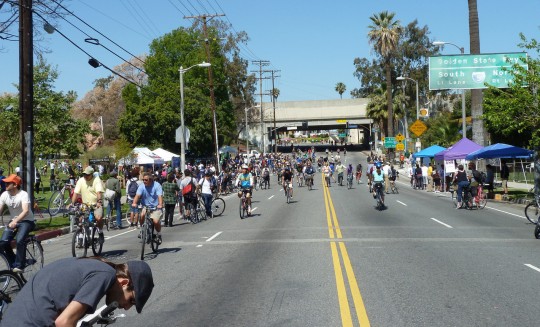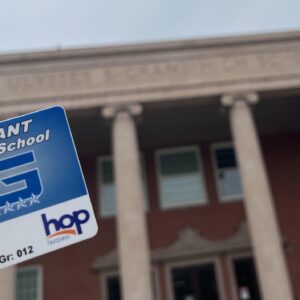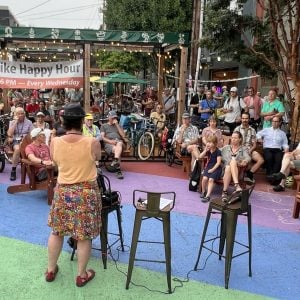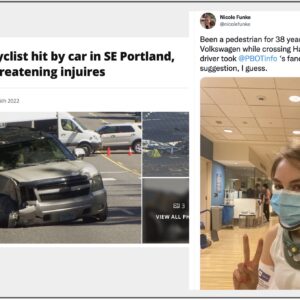
(Photos: Ted Timmons)
This is a guest post from BikePortland reader Ted Timmons, who visited L.A.’s version of Sunday Parkways this year and was moved to write up some of his observations.
Perhaps unsurprisingly, Los Angeles was late to the ciclovia scene, even by American standards. However, they have had several per year since late 2010.
While the stereotype of Los Angeles revolves around its infatuation with the car, it’s arguably the densest urban area in the country. The percentage of trips in Portland by means other than car is about 16 percent; in Los Angeles, it’s 25 percent.
So, that leads us back to ciclovias — “Sunday Parkways” in Portland parlance, or “CicLAvia” in Los Angeles. Over 100,000 participants showed up to the very first CicLAvia, and the numbers have been that high ever since. Compare that to Portland’s numbers of 10-20,000 per event.
Perhaps intentionally, CicLAvia routes typically connect through poorer neighborhoods, which caused income classes to interact in an atypical way.
Advertisement
There’s a problem caused by CicLAvias that is both stereotypically Los Angeles and something that occurs in Portland: while the event is a celebration of humanity without intrusion from cars, large numbers of participants drive to the events. This can be seen in Portland events like the World Naked Bike Ride and the Bridge Pedal. As with those annual Portland events, this habit annoys many Angelenos who feel these people are missing the point of the event.
Further, the CicLAvia events are so popular they suffer from an unusual problem: they aren’t friendly for fast “club riders.” They are so crowded with citizens walking, skateboarding, rollerblading, and cycling that there’s very little room to ride at speeds above 15mph. And as might be expected in Los Angeles, the participants deal with the problems of scale: traffic jams.
These are two big problems. But they are blessings in disguise. Why? Experienced cyclists don’t need to drive to a car-free event, nor do they need a car-free event to feel safe enough to ride on the streets. Inexperienced cyclists may only take their bike out once or twice a year (as those who ride Sunday Parkways or the Bridge Pedal may have observed). They may have a WalMart Huffy with aging and underinflated tires. They may have packed it into the Canyonero to go five miles to the event. But that means they are riding!
Perhaps riding in a car-free event will inspire our neophyte riders to substitute the bicycle for their car in one trip next week. Maybe they’ll start commuting, or helping their child ride to school. As experienced cyclists, it should be our mission to support these riders, rather than snub them for riding slowly or driving to the event.
The ciclovia declares that streets are for everybody — and everybody’s a lot of people. We should learn from CicLAvia and keep growing Sunday Parkways with that in mind.
Ted has attended Ciclovia-style events in Bogota, Quito, Portland, and Los Angeles.






Thanks for reading.
BikePortland has served this community with independent community journalism since 2005. We rely on subscriptions from readers like you to survive. Your financial support is vital in keeping this valuable resource alive and well.
Please subscribe today to strengthen and expand our work.
And from the photos, it looks like they actually route it on arterials rather than smaller neighborhood streets. Now that’s something worth coming out for!
Yeah, the routing on neighborhood streets makes Portland’s Sunday Parkways become congested with a much lower throughput of people riding or walking. I get that the City wants to introduce people to the neighborhood greenways, but I don’t think this is the way to do it. I’d recommend instead using signs like this to let people know about bikeways in their neighborhood:
PBOT already installed some Neighborhood Greenway signs under the Speed Limit signs. Also, Clinton, Going, and maybe one more? have bike cutouts above the street signs.
Your example from Vancouver BC could be great for the downtown cycle tracks, though.
I could be wrong, but I don’t think the bike cutouts are very prominent at the greenways’ intersections with major streets (e.g. Clinton / Chavez, Clinton / 50th, Woodward / 52nd). They seem to mostly be aimed at telling people who are already travelling on Clinton (e.g.) that it is a bike boulevard. The signs I have in mind would tell people speeding past the boulevard every day in their Canyonero that a bike boulevard exists (and maybe you could use it!)
They are as prominent as that tiny little bike symbol you are advocating for. Ours are a bright color and stand out. I don’t think spending tax payer dollars to change our street signs so minutely would have any impact on where people rode there bicycle.
Those signs are so small that my cohabitant never noticed them until I pointed them out as a pedestrian.
Given recurring problems with cut through traffic in Portland, we need large and visible bike route signs. On greenways, I’d like to see route signs with “cars are guests” or “bikes and peds have priority” on them but even a MUTCD compliant BMUFL sign would be a huge improvement over microscopic signs and confusing sharrows.
I’d rather they skip the signs and spend that money on PSA’s and educating the driving public as to what and how they should act on a bike blvd.
all the white paint and signs of bikes and pedestrians in the world won’t mean anything unless the public is educated and tested on the subject.
You can poll just about any driver on the road “what does a sharrow mean” and you’ll never get a straight (or correct) answer from them. The same goes for about 50% of traffic law, they haven’t been educated or tested on these subjects since they got their license.
We need to fix the problem and stop putting band aids on everything!
Add enforcement of speed limits and passing distances to your proposal, and I’m sold.
Driver education is sorely lacking. Driving on I5 south today, I realized that the ever present slowdown just after the offramp to 405 is due to a simple lane reduction merge. Everybody wants to zoom to the front instead of zipper and it just brings traffic to a halt. If divers can’t learn this, they should have zipper merge drills at least weekly. I’m thinking maybe we don’t have congestion, only incompetence.
Both/And, please? I think education and enforcement are both sorely lacking, to be sure. But I also think that our greenway system is far too low-profile. I’ve talked to a number of people who spent a painful week or two as novice bikers on major inner Portland streets with no bike facilities and now use greenways instead once they learned the “secret.” I suspect there are more who didn’t realize the greenways were there, or found them too challenging to find, and would still be biking now if they were better marked.
This is a valid argument for adding cycle tracks to our arterials. People know Hawthorne, Burnside, Division, etc. They don’t necessarily know that they’re “supposed” to be one block over.
We’re all supposed to be driving cars like the responsible car-driving, interest-paying adults who build and maintain our infrastructure or enforce and adjudicate our traffic laws.
Having volunteered at Sunday Parkways multiple times before moving to LA, the biggest difference is there are volunteers at the intersections where car traffic crosses the route, to assist the police. All other intersections simply have barricades or tape. And yet I have never seen a car on the route, which was a constant problem at Sunday Parkways.
“And yet I have never seen a car on the route, which was a constant problem at Sunday Parkways.”
when you shut down a neighborhood street you can’t deprive people of their “right” to drive to their house…
when you shut down an arterial street there’s no expectation that you can still drive on it…
There is no such “right to drive to your house”. The routes are publicized well in advance and residents have ample time to move their cars off the route if they need to drive. Plus, it’s only a few hours on a Sunday. Deal with it.
The only exception being people with disabilities that can’t walk the few extra blocks.
Most Americans have a mental disability that leads them to believe that they have to park within 50ft of their destination…
A lifetime of driving everywhere breeds chronic laziness.
You are one of the few posters here who actually consider the needs of people who cannot ride a bike or walk. Try talking care of an elderly parent. Bikes don’t cut it for that. It’s amazing how anti-disabled many BP posters are.
too bad we don’t have an official bike buddy site, where folks too nervous to switch from car free events like these, could make the move to commuting or running errands on a bike on a more frequent basis, if they had a little help and guidance. Its a very big jump to do this on your own, especially given our city’s bad roads, dissapearing lanes etc, etc.
Yes! If someone sets this up, I’ll be among the first to volunteer. I think Bicycle Transportation Alliance does something like this, but only during the Commute Challenge. Maybe they could keep the Buddy program going year-round.
What a great idea! I was lucky enough to have a sister in town who was already an avid cyclist, and she helped me over the first hurdles. But she didn’t do a lot of errands by bike, and I had to figure that out on my own. I’d love to pay forward what I’ve learned.
Great post, thanks! I’d love to see an expansion of Sunday Parkways to every Sunday in the summer, and not just once a month. And yes, more arterials. Sunday Parkways should open up hostile streets to cycling (Hawthorne, 82nd, etc.) – giving people a taste of what car-free business districts could be like – and not just use the already-car-lite Greenways.
Los Angeles has a pretty awesome bicycle culture overall. I participated in a couple of these in 2010-2011, and they are truly incredible to behold. The scale is just tremendous – imagine the combination of every Sunday Parkways route, connected via major arterial streets, closed in both directions.
Amen. It has had one for a long time; I grew up there and moved away in 1978. There is a LAB touring club that has existed there since the 1940’s, there were numerous racing clubs and regular races even in the late 60’s.
As a cycling environment it wasn’t bad–wide streets, lots of secondary roads to ride that connected in a rational grid. I never thought that traffic engineers did drugs on the job until I moved to Portland!
Ooh, if we’re throwing in Sunday Parkways suggestions, a route in outer NE would be welcome. Also possible collaboration opportunity with our Gresham neighbors…
In Boston, they close a huge street (Memorial Drive, similar in size and function to Powell) every Sunday to make it available to cyclists, skaters, and people on foot. It’s wonderful!
http://www.bostoncentral.com/activities/Biking/p907.php
Technically in Cambridge, but yeah, it’s great!
So about 1.6-3.3% of Portland is taking part in Sunday Parkways events and about 2.6% of the L.A. population taking part in the cycLAvias.
Don’t assume that those who drive to the event live within even 10-15 miles of the event. We’re talking LA here, and cycling in from OC or Long Beach is a no-go. Especially some of the neighborhoods you DON’T want to cycle through alone. Ourselves, for example, drove to the PDX WNBR. NINE HOURS of driving to our friends in Clackamas. WNBR was just part of the annual trip.
Higher population. Probably only one event per year. No wonder it beats Sunday Parkway numbers.
They do at least 3 or 4 during the year.
Interesting article to be sure, and as a former Los Angeles resident (West Hollywood actually), I also struggle to buy into 25% of transport is other than car. Not gelling with my experiences at all. Look, I like LA, and hope that it can be a leader in alternative transportation forward. Especially with the air pollution inland. I also understand and have watched the attempt at infrastructure improvement to facilitate LA’s multi-modal aspirations. That stated, it is at least a decade behind PDX, if not 2 decades in terms of adoption.
LA has really high public transit ridership. I imagine our bike and walk share numbers are much higher.
Considering how you lived in WeHo, of course you wouldn’t see how 25% of LA gets by without a car. Have you ever seen the buses and transit anywhere east of Fairfax? Or all of South LA? LA has loads of 60ft long busses, PDX has none. If you look at Metro/LRT ridership, not only is LA’s MetroRail busier than MAX, but ridership per mile is also higher, so LA’s system is more effective than PDX’s. LA also has an expanding heavy rail subway, PDX has none.
Up here in Vancouver, USA we only got a one day event in 2014, and none this year.
Anyone up for helping attempt one or two for 2016?
Has Portland ever closed a major arterial for Sunday Parkways? Not that I can recall. Those routes are almost all on existing bikeways or green streets for whatever. Bridge Pedal, yes, but the PBOT events, No! Why not?…don’t want to inconvenience or anger motorists! Go PBOT!
Part of SW Terwilliger was closed for the Sunday Parkways.
And that angered the motorists, now look what happened.
Not a major street. Barbur would be the equivalent of Venice Blvd (the route of the most recent CicLAvia). Los Angeles has also used Wilshire blvd at least twice for CicLAvia, which is similar to Burnside or Sandy, but even larger.
I would argue there’s a not a single thing that Portland needs to learn from L.A. In fact, there’s more than enough California floating around town lately.
Where does Portland have this?
http://la.streetsblog.org/2015/04/03/city-of-l-a-s-first-parking-protected-bike-lanes-reseda-boulevard/
sw broadway since 2009. and i’m not a fan.
Broadway. the Hawthorne Bridge. Moody Avenue.
L.A. can have it if L.A. agrees to stay in L.A.
The Broadway cycle track is one-way, and is much shorter than the Reseda Cycle Track. Also, LA has the Rosemead Cycle Track in Temple City. Considering how LA has more and better cycletracks than PDX, and they are all located in the suburbs…they are ahead of PDX in that area.
It’s all in the infamous number games.
Yes LA see’s an impressive 100,000+, but they also have a population (just the city itself – not the burbs) of nearly 4 million. Portland about 650,000.
In other words LA is about 6 times the population of Portland – which means as a percentage of population Sunday Parkways is as popular to way more popular event (if you go by metro region stats 13 million for LA- 2 million for Portland).
And those same problems you mention for LA are equally true for the Parkways as well.
Correction: Sunday Parkways events are 10,000 to 31,000 – averaging 20,000 plus per event.
One thing that would make these new ideas come to life would be more volunteers. We are needing lots more volunteers for our upcoming SE event on August 23rd. We are taking a page from LA and most other arterial street Open Streets events and having volunteers manage some intersections without police or reduced police presence! That means we need 30 more volunteers! If you haven’t volunteered yet this year, this is the event to do it! We need you! Sign up at http://www.portlandsundayparkways.org
And thanks for some of the suggestions for the Sunday Parkways program. We are looking forward to our newest route in Sellwood with the Tilikum Crossing at the end of September. More new ideas and program enhancements to come…
I realize this is a specific post about CicLAvia (which the current mayor has pledged to make a monthly event before he leaves office and currently occurs 3 to 4 times a year along major arterial streets and in the City’s downtown) but as an Angeleno I feel compelled to defend the City’s (slow) movement towards livability more broadly, which has largely flown under the radar or seems to go unrecognized.
For example, did you know that Los Angeles has implemented 50 miles of road diets (http://la.streetsblog.org/2014/07/02/ladot-has-completed-more-than-50-miles-of-road-diet-bike-lanes/) and that 20 of those miles were completed in a single year? (https://ladotbikeblog.wordpress.com/2013/09/06/the-year-of-the-road-diet/). Sure you could argue that we have so many streets that doing this is “easy” but most of LA’s streets are residential so these efforts shouldn’t go unnoticed as they are occurring primarily on collector, and some cases arterial streets. This does not include the sort of “road diet” implemented on Broadway in Downtown LA in which travel lanes were removed to expand the sidewalks and provide outdoor dining (http://la.curbed.com/archives/2014/12/all_the_data_you_could_ever_want_on_walking_driving_riding_and_parking_along_bustling_broadway.php)
Additionally, Los Angeles has a “People St” program which is slowly reclaiming space from automobiles to create pedestrian plazas (http://peoplest.lacity.org/)
As someone else pointed out, Los Angeles installed its first true protected bike lane recently and more are on the way. The “My Fig” project will connect USC to Downtown LA and is slated to break ground next year (http://www.myfigueroa.com/) and the City was awarded funding to construct a 3 mile cycle track on Chandler Blvd which will connect to the heavily used NoHo Red Line Metro Station. Which brings me to my next point, Los Angeles County is embarking on the largest light rail construction expansion in the nation, with the Expo Line and Gold Line extensions expected to open next year and more projects all which will be completed by 2026 (check out the interactive map/timeline of projects here http://www.metro.net/projects/)
Semantic PSA: When the streets are closed to people in cars, I like to think of the streets as finally being “open” … to all the people on bikes, rollerblades, skateboards, in wheelchairs, and to those who skip, walk, jog and dance.
Sure, the streets are closed at these events, but more it may be more accurate to say that the streets are finally open.